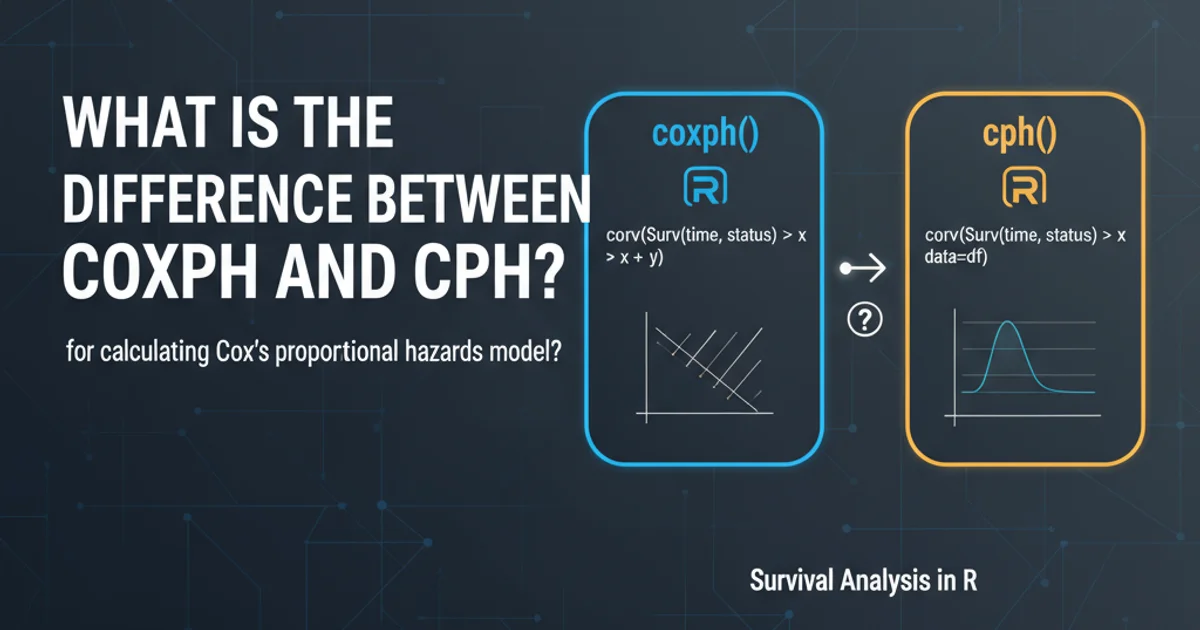What is the difference between the coxph and cph functions for calculating Cox's proportional haz...
Categories:
coxph vs. cph: Demystifying Cox Proportional Hazards in R

Explore the key differences and appropriate use cases for the coxph function from the survival package and the cph function from the rms package in R for Cox proportional hazards modeling.
When performing survival analysis in R, particularly using Cox proportional hazards models, two prominent functions often come into play: coxph from the survival package and cph from the rms (Regression Modeling Strategies) package. While both are designed to fit Cox models, they originate from different philosophical approaches to statistical modeling and offer distinct features and advantages. Understanding these differences is crucial for choosing the right tool for your specific analytical needs.
The coxph Function: The Workhorse of Survival Analysis
The coxph function, part of R's base survival package, is widely considered the standard implementation of the Cox proportional hazards model. It is robust, well-established, and provides a comprehensive set of tools for fitting the model, checking assumptions, and performing various post-estimation analyses. Its strength lies in its flexibility and the extensive ecosystem of functions built around it for survival data handling.
library(survival)
# Load a sample survival dataset
data(colon)
colon <- subset(colon, etype == 2) # Recurrence-free survival
# Fit a coxph model
fit_coxph <- coxph(Surv(time, status) ~ sex + age + factor(nodes), data = colon)
summary(fit_coxph)
Example of fitting a Cox proportional hazards model using coxph.
survival package is fundamental for survival analysis in R. Familiarize yourself with its Surv() object and plotting functions like survfit() and ggsurvplot() (from survminer).The cph Function: Embracing Regression Modeling Strategies
The cph function is a core component of Frank Harrell's rms package. The rms package emphasizes a more principled approach to regression modeling, focusing on issues like appropriate handling of continuous predictors (e.g., using restricted cubic splines), model validation, and robust inference. cph integrates seamlessly into this framework, offering enhanced capabilities for flexible modeling and graphical representation of results, especially for complex relationships.
library(rms)
# Ensure data is a data.frame for rms functions
dd <- datadist(colon)
options(datadist = 'dd')
# Fit a cph model, potentially with splines for continuous variables
fit_cph <- cph(Surv(time, status) ~ sex + rcs(age, 3) + factor(nodes), data = colon, x=TRUE, y=TRUE)
summary(fit_cph)
# Plotting effects (e.g., for age)
plot(Predict(fit_cph, age))
Example of fitting a Cox model with cph, including restricted cubic splines for 'age'.
graph TD
A[Survival Analysis in R] --> B{Choose Cox Model Function}
B --> C[survival::coxph]
B --> D[rms::cph]
C --> C1["Standard, widely used"]
C --> C2["Flexible for basic and advanced models"]
C --> C3["Extensive ecosystem for post-estimation"]
C --> C4["Good for general survival tasks"]
D --> D1["Part of Regression Modeling Strategies (rms)"]
D --> D2["Emphasizes flexible modeling (e.g., splines)"]
D --> D3["Integrated with model validation & graphical tools"]
D --> D4["Ideal for complex predictor relationships"]
C1 & C2 & C3 & C4 --> E["Focus: Robust, general-purpose Cox modeling"]
D1 & D2 & D3 & D4 --> F["Focus: Principled, flexible regression modeling"]
E --> G["When to use: Standard analyses, compatibility"]
F --> H["When to use: Complex relationships, advanced validation"]Decision flow for choosing between coxph and cph.
Key Differences and Considerations
While both functions estimate coefficients for the Cox proportional hazards model, their underlying philosophies and feature sets lead to several practical differences:
- Package Ecosystem:
coxphis part of thesurvivalpackage, which is a foundational package for survival analysis.cphis part ofrms, a package focused on comprehensive regression modeling strategies. - Handling of Continuous Predictors:
rms(and thuscph) strongly advocates for using flexible functions like restricted cubic splines for continuous predictors to avoid linearity assumptions. Whilecoxphcan also use splines (e.g., viasplines::ns),cphintegrates this more seamlessly into its workflow. - Model Validation and Diagnostics:
rmsprovides extensive tools for internal validation (e.g., bootstrapping, cross-validation) and graphical diagnostics, which are often more integrated and streamlined withcphmodels. - Output and S3 Methods: The output objects and available S3 methods (e.g.,
print,summary,plot,predict) differ.rmsobjects often have richer methods for visualization and prediction, especially when dealing with non-linear terms. - Default Behavior:
cphoften requires explicit settings for certain behaviors (e.g.,x=TRUE, y=TRUEfor some post-estimation functions), reflecting its design for more rigorous analysis. - Interpretation of Coefficients: The core interpretation of coefficients as log-hazard ratios remains the same, but the way these are presented and visualized can differ significantly, especially for non-linear terms.
coxph is perfectly adequate. cph becomes particularly powerful when you suspect non-linear relationships with continuous predictors or when you need advanced model validation and graphical capabilities.When to Use Which Function
The choice between coxph and cph often comes down to the complexity of your model, your familiarity with the respective package ecosystems, and your specific analytical goals:
Use
coxphwhen:- You need a straightforward, widely understood implementation of the Cox model.
- Your primary focus is on estimating hazard ratios for simple linear effects.
- You are integrating with other
survivalpackage functions or packages that expectcoxphobjects. - You are performing basic assumption checks (e.g., proportional hazards).
Use
cphwhen:- You suspect non-linear relationships between continuous predictors and the hazard, and want to model them flexibly (e.g., with restricted cubic splines).
- You require robust internal model validation (e.g., bootstrapping, cross-validation) as part of your analysis.
- You want to leverage the extensive graphical and prediction capabilities of the
rmspackage for visualizing complex model effects. - You are following a comprehensive regression modeling strategy that emphasizes careful handling of predictors and model assessment.
In essence, coxph is the reliable workhorse for general survival analysis, while cph offers a more sophisticated, principled approach for complex modeling scenarios, particularly when dealing with continuous predictors and requiring advanced validation. Many researchers use both, choosing the tool that best fits the specific question and data at hand.